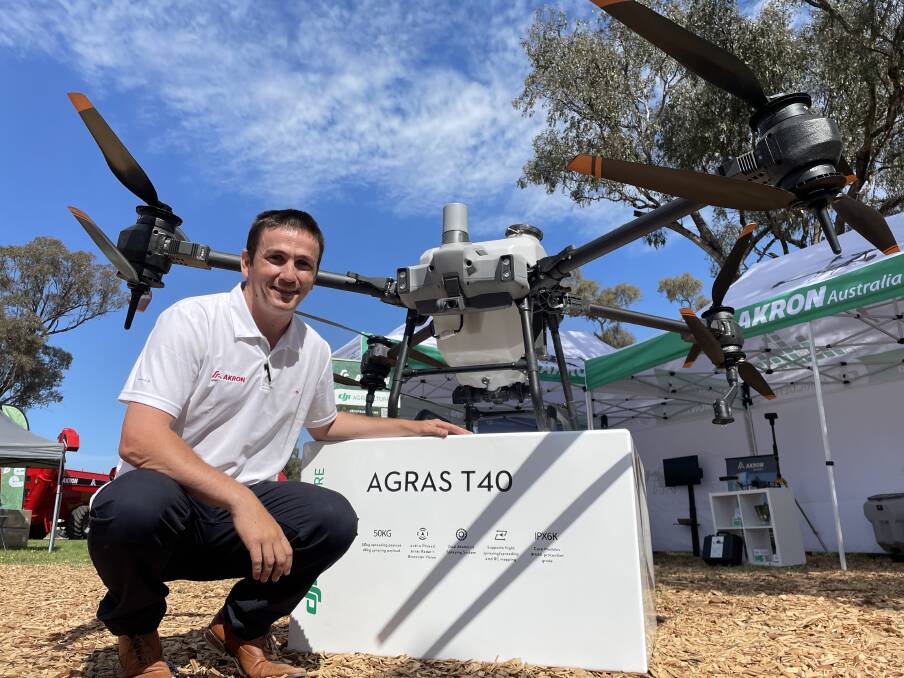
The pace at which drone technology is advancing is helping drive uptake as battery life and run times shift into viable territory.
Subscribe now for unlimited access to all our agricultural news
across the nation
or signup to continue reading
Bigger payloads and more sophisticated programming have reached a point where the drone is now as much a part of the farm as the quad bike.
Akron Australia chief executive officer, Jimmy O'Neill, Gerogery, was at Henty and for the first time had on show the Agras T40 drone.
He resorted to using a drone in the past few wet years to spray crops when he was unable to get ground rigs onto paddocks.
"We started using it ourselves because we needed it, because we've had a real wet three years and we were losing our yield by not being able to get onto the paddocks and spray," he said.
This meant he could get urea onto paddocks when needed, allowing him to capitalise on available moisture.
"We started to see the benefits of it and we realised, well, why isn't there more of this going on around us?" he said.
Mr O'Neill said one of these units cost around $35,000 to get set up and in the air.
"That gives you your drone, your remote, three batteries and a charger," he said.
This did not include CASA licensing, which he said wasn't necessary for working on your own farm.
"But if you go out contracting, you 100pc need it," he said.
Licencing began at a cost of $6000, depending on the provider.
The Akron drone can hold a 40 litre spray load or 50 kilogram spreading load and could cover 15 to 20 hectares an hour.
"So it's actually very viable now, whereas a couple of years ago you had drones coming back every three to four minutes and you were refilling, but now they're coming back every 10 minutes," he said.
From a servicing perspective, a "good check over" was required each time it returned from a run.
"We've done 120 hours with this one and we've only had to replace one propellor," he said, of the demonstration unit he had on site at Henty, "and that's only because an eagle went at it".
The whole unit runs off recharbale lithium batteries, which provide about 1500 cycles before performance began to decline.
The batteries charged off a generator when in the paddock on application runs.
Contractors had been the main source of inquiry, especially now they could see the required technology and efficiency.
"Now the technology's there, they're seeing the turning point - this is a game changer now," Mr O'Neill said.
Now the technology's there, they're seeing the turning point - this is a game changer now.
- Jimmy O'Neill, Akron Australia.
One of those changes has been pre-programming to not just know which section of the paddock a machine was up to after it docked to refill, but it could now return to the closest section of that run.
"It won't go back to where it finished. It'll come back to its closest run, just for battery efficiency," he said.
All the mapping for runs can also be set ahead of time and run from the lounge room at home, if needed.
Additionally, droplet size could be adjusted to respond to prevailing weather and the whole unit, empty and no battery, was 38kg.
Delta Ag national brand manager, Dean Kinlyside, said the AgDrones Australia drone, on Delta's site at the field days, had, likewise, generated strong interest.
He said in terms of value for money, the drones still wouldn't beat a self-propelled unit or tractor-pulled spray rig, but with the overall operation efficiency and mapping capability they now offered, they were attracting interest from national parks, councils, through to farmers.
Like the Akron offer, the Agdrones Australia unit was $35,000 with three batteries and a charger and included a 1000 cycles battery warranty and typically did trips of 10 to 12 minutes between reloads with a 40L tank capacity and a 98kg gross take-off mass.
Mark Spessot, XAG Australia, who was also at Henty, said the said the Riverina had been slower in its adoption, but he fielded a high level of interest at the field days.
"There is interest in and around the Riverina - uptake hasn't been as strong, but the area has not been targeted enough by drone distributors," he said.
Mr Spessot said the uptake was 35 per cent up on the previous year.
More broadly, he had found demand from Queensland had been particularly strong.
"The uptake in Queensland is phenomenal, they have been early adopters," he said.
"These machines are fully automated and we're talking centimetre accuracy.
"They fly closer to the ground, four to six metres and you're getting an eight metre spray swath ... it's absolute precision."
Mr Spessot said they had not just been involved in farming, with the drones also used in a trial to put out baits targeting fire ants in Queensland.
With five news models from 2017 to 2023 Mr Spessot said the technology was advancing rapidly, with the biggest difference being the lift capacity.
The P20 model in 2017 had a 20kg payload. The 2023 P100 Pro had a payload of 80kg.
"Other advances are terrain following - you see the aircraft hug the contour of the flying field, collision avoidance systems and better automation systems which are more efficient in the way they fly," he said.
Start-up company Droneland had also debuted at Henty and general manager Adam Mitchell said demand had been good.
Droneland business development manager Jim Dula, said farmers could use the surveying drones to map the paddock first and build in obstacles before sending out the larger spray drone.
With changing technologies Mr Dula said he looked forward to increased integration and automation between the two.


